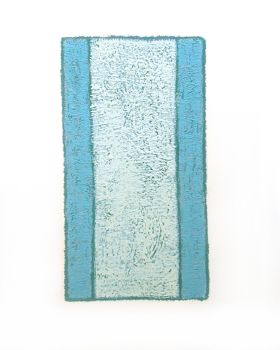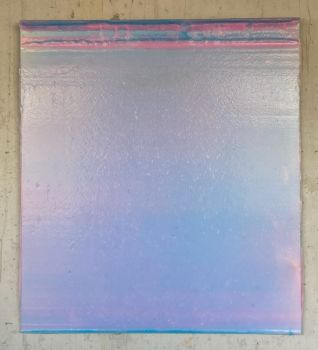'Personal Structures', a captivating art project without boundaries
How did it started?
The idea for this project goes back several years. Already in the spring of 1998, the artist Rene Rietmeyer from the Netherlands decided to contact various artist colleagues in order to enter into a close exchange of ideas with them and, if possible, to work together occasionally.
 Rene Rietmeyer sitting behind his typical boxes, "The Netherlands Brabant March 2000"
Rene Rietmeyer sitting behind his typical boxes, "The Netherlands Brabant March 2000"
During his numerous travels, which sometimes included stays of several months in many European countries, the USA, Canada and Japan, he met artists who were working with similar intentions and formal means comparable to those of his own.
The observation that even in the most distant corners of the world and independent of one another, closely related artistic problems are being worked on, often for surprisingly similar reasons and using comparable languages of form, led to the idea of bringing several of these artists together.
 The typical white illuminating, 'Japanese' boxes by Tomijo Ogawa, 2000
The typical white illuminating, 'Japanese' boxes by Tomijo Ogawa, 2000
With this undertaking, the goal was to start communication with and among the artists, and whenever possible, to offer them a forum - whatever form that may take. Hence, from the very beginning, internationality was an important factor, which considerably influenced the conception and demands of the project.
What does Personal Structures stand for?
The first working title of "Personal Statements" had now changed in to “Personal Structures”. This new title, an allusion to the famous minimalist exhibition "Primary Structures" of 1966, should both hint at a certain "minimalist" legacy as well as an evident difference to this type of art.
The first and most important criterion for the selection of the artists was that their works display "minimalist" characteristics, employed in an individual, subjective, personal or emotionally-influenced manner.
 Steel and concrete cubes by Nelleke Beltjens, 'Gray in color' 2003
Steel and concrete cubes by Nelleke Beltjens, 'Gray in color' 2003
Characteristics such as the simplification of forms (or rather: the concentration or condensation of forms), serialization, the tendency towards creating objects and towards spatial installations were all to be employed, either together or in varying combinations, in such a way that instead of formal self-reference to the creation of an emotional atmosphere, the aim is to evoke a unified general atmosphere in the room, and to generate communication with the viewer.
 Eternal Memory', heavy, iron books made by artist Takashi Suzuki in 2000
Eternal Memory', heavy, iron books made by artist Takashi Suzuki in 2000
This characterization, at that time still kept very vague and general, proved a very effective search filter in the selection of the artists and their works. Departing from Rietmeyer's own work, which had developed from traditional painting more and more into multi-part installations of objects, the attention was first directed to works in the border area between painting and making objects.
 'Cobalt Blue, 2004' by Paul Raguenes, wood, tar and pigment
'Cobalt Blue, 2004' by Paul Raguenes, wood, tar and pigment
Artistic development of Personal Structures
In the beginning the focus was finding artists who were interested in further developing painting into the three-dimensionality of a picture object (if indeed one may still speak of "picture") and, thus, outwards into real space.
But over time, it became increasingly clear that even with artworks which can be clearly attributed to the genres of painting or sculpture, it is possible to express their intentions of adopting their own minimal language of forms, as well as their tendency towards emotionalizing the work and towards creating installations which define space.
 Installation '#8, #9 and #10', July 2003, by Marcus Abel
Installation '#8, #9 and #10', July 2003, by Marcus Abel
This especially applies to instances where painterly or sculptural positions are defined as material- or process-oriented and the boundaries between the genres are critically and experimentally expanded.
It becomes very clear here that subjectivity and personality do not necessarily have to manifest themselves in an expressive language of forms and in a rhetoric of gesture, but may rather very subtly unfold, in an interplay between subjective decisions, conceptualizations and the self-dynamics of materials and working processes, putting themselves into question at the same time.
 Germany Bonn November 2001, oil on wood, Rene Rietmeyer
Germany Bonn November 2001, oil on wood, Rene Rietmeyer
Group or an organization?
Personal Structures is not an artist group, at least not in the sense of an artist group within the classical modern movement. Generally, such artists adhered to a binding program, and were often organized in an association with certain membership rules.
 Typical colorful, silicon works by Frank Piasta 2000-2010
Typical colorful, silicon works by Frank Piasta 2000-2010
Personal Structures can be compared to an open forum, where different individuals meet and communicate. These project is not concerned with rigid delineation, but aims at openness and exchange. Personal Structures deals with artists coming together who have their own ideas, goals, and working methods, but who yet have enough in common that they may be seen as related.
 'Portrait of David Salle', Miami February 2001, oil on wood by Rene Rietmeyer
'Portrait of David Salle', Miami February 2001, oil on wood by Rene Rietmeyer
'Thread of thought'
The famous "thread of thought", which extends throughout their works, referred to here by the name Personal Structures, has not been determined through a definition of concepts and fixed programs, but is rather similar in the way that family members are similar, as Ludwig Wittgenstein described it: "[...] the strength of the thread does not reside in the fact that some one fiber runs through its whole length, but in the overlapping of many fibers."
 Rene Rietmeyer, Portrait of S and K, February 2011, exhibited at the 54. Venice Biennale 2011
Rene Rietmeyer, Portrait of S and K, February 2011, exhibited at the 54. Venice Biennale 2011
For the viewer of the works and the reader of the artists' interviews, there will then comeabout at least this is what we hope for – the attractive situation of discovering these individual "fibers" as well as the many comparisons and similarities in detail.
In doing so, these viewers and readers will be able to understand that related theoretical positions express themselves in very different results. And that in turn, visually similar works of art may arise from very different approaches and before very different cultural and personal backgrounds.
 'Troug Cadmium Yellow Deep', 2003, made of beewax and wood by Johannes Girardoni, Ludwig Museum 2005
'Troug Cadmium Yellow Deep', 2003, made of beewax and wood by Johannes Girardoni, Ludwig Museum 2005
Well-known artists and Personal Structures
While the list of participating artists has evolved over the years, featuring both emerging talents and established names, some notable artists have been associated with "Personal Structures" at various points. These have included, besides the ones already mentioned and displayed in this article:
- Yoko Ono, known for her conceptual art and peace activism.
- Carl Andre, an American minimalist artist recognized for his ordered linear format and grid format sculptures.
- Richard Long, an English sculptor and land artist best known for his work in the natural environment.
- Lawrence Weiner, one of the central figures in the formation of conceptual art during the 1960s.
- Marina Abramović, a Serbian performance artist whose work explores body art, endurance art, and feminist art.
- Sean Scully, an Irish-American painter known for his contributions to abstract art and his distinctive use of color and form.
- Hermann Nitsch, an Austrian avant-garde artist known for his controversial performance art.
- Tony Cragg, a British sculptor acclaimed for his dynamic, often organic forms.
The movement's inclusive approach allows for a wide-ranging exploration of its core themes, making it a vibrant and evolving collective of creative minds. Participation can vary from one exhibition to the next, reflecting the project's commitment to showcasing a broad spectrum of voices and perspectives in contemporary art.
 'Everglades #5,#2, #1', 2003 oil on wood by Yuko Sakurai
'Everglades #5,#2, #1', 2003 oil on wood by Yuko Sakurai
Where can I see or buy this art nowadays?
Many of the works of are available in galeries or can be seen in musea. Though in spring 2024, Venice will host an exhibitions and one of them is Personal Structures (from April 20th to November 24th) organized by the European Cultural Centre (ECC) in Italy.
A wide selection of artworks from internationally renowned and emerging artists, photographers, and sculptors as well as worldwide academic institutions will be featured.
The exhibition will take place in Palazzo Mora and Palazzo Bembo.
 Palazzo-Bembo in Venice as part of the Biennale 2024
Palazzo-Bembo in Venice as part of the Biennale 2024
Online you can see and buy a large collection of Personal Structures artworks at the European Culture Center (ECC) and at Gallerease Selected.
*In the header the installation by Rene Rietmeyer "Portrait of Rauschenberg January 2002"


























